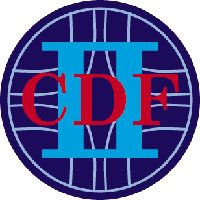On the eve of the shutdown of Fermilab's Tevatron, collaborators from the CDF and DZero experiments are expressing their gratitude for all the hard work and dedication that made 26 years of capturing billions of proton and antiproton collisions possible. In these final hours of operations, both collaborations are making the pen mightier than the proton by writing notes of thanks and appreciation. A live broadcast of the shutdown activities that will take place in the CDF and DZero control rooms and the Main Control Room will begin tomorrow, Sept. 30, at 2 p.m.
Thank you from CDF
On October 13, 1985 at Fermilab, the Tevatron produced protons and antiprotons collisions inside the CDF detector for the very first time. It was a magical day for the few dozen people in the accelerator and CDF control rooms. Since that day, literally billions of matter-antimatter collisions took place inside CDF and then inside CDF and DZero. What was once novel is now routine – and routine at an unprecedented scale. The intensity of the beams gradually multiplied, thanks to the relentless efforts of the Tevatron accelerator physicists.
Friday at 2 p.m., after nearly 26 years of operation, a switch will be turned, ending the career of one of the most remarkably successful colliders ever in particle physics. The Tevatron collider established a brand identity for Fermilab and changed the physics landscape forever.
This program allowed CDF to achieve numerous physics highlights, including the discovery of the top quark, the precision measurement of the W boson mass, the observation of Bs mixing and the many limits set on potential new physics theories. Many of these results appeared in this column.
More than 3,000 physicists contributed to this rich program at one point in their career. Five hundred and thirty two students have received their Ph.D. in this program thus far, and the experiment produced a steady flow of more than 550 publications (and counting) in refereed journals. Now with a full dataset of 10 inverse femtobarns under the hood, CDF scientists expect to produce another hundred or so papers in the coming years.
The success of a program like this goes well beyond just those scientists involved. Twenty six years of fruitful operation requires a commitment from everyone here at the laboratory. From the accelerator scientists, to the technical staffs, the people in the business systems and those that maintain the laboratory infrastructure – each of you played a role in this success story. What a run it’s been – we should all be very proud of what we, as a team, accomplished. On behalf of all the members of CDF: Thank you, Fermilab. We did it together, and we did it very well!
—Rob Roser and Giovanni Punzi,
CDF co-spokespersons
Thank you from DZero
As the DZero collaboration prepares to join in tomorrow’s festivities and celebrate the Tevatron, we would like to take the opportunity to recognize those who have helped make the DZero experiment a success over the years.
To the Accelerator Division goes our gratitude for providing proton-antiproton collisions with remarkable reliability at beam intensities far beyond the design goals of the Tevatron. Their effort to optimize the delivered integrated luminosity to the experiments assured continuing success of our physics program.
The Particle Physics Division hosts the experiment construction and operations and a large fraction of the experiment’s physicists. The division assured reliable, safe and productive operation of the experiment.
We rely on the efforts of the Computing Division to perform the intense processing that transforms our raw data into the reconstructed physics objects that we use for analysis. Computing Division stores and provides access to our large data set and administrates the large farm of computers we rely on for our physics analyses.
Thanks to all laboratory personnel for providing services critical to the life of this large, international collaboration which culminated in many discoveries and exciting measurements at the Energy Frontier collider.
Much of our support comes from outside the laboratory, and we would like to acknowledge all of the universities and laboratories that are involved in the DZero experiment. Also critical to our success is the continuing support of many national and international funding agencies, especially that of the Department of Energy and the National Science Foundation.
Finally, we would like to give a very special thanks to our families and to the families of those thanked above. Though as a collaboration we keep careful track of every collision that occurs and each event that is stored, we tend to lose track of the number late nights, long weekends and 3 a.m. expert phone calls that add an intangible cost to our efforts to succeed!
The DZero collaboration is looking forward to producing many excellent physics results as we examine our complete data set from Run II of the Tevatron!
—The DZero Collaboration








